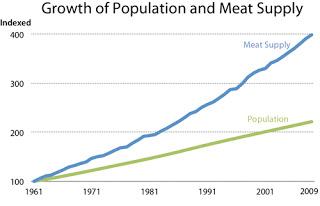

| Online: | |
| Visits: | |
| Stories: |

| Story Views | |
| Now: | |
| Last Hour: | |
| Last 24 Hours: | |
| Total: | |
The impact of livestock on climate change
Read aguanomics http://www.aguanomics.com/ for the world’s best analysis of the politics and economics of water
Nada writes*
Climate change is a rising concern today. Among the different factors contributing to global warming, studies have shown that raising livestock and animal agriculture contributes with a significant share. With a rising increase in the world’s population, and thus a rising need to increase meat production, we find this issue only increasing in size. According to the Food and Agriculture Organization of the United Nations [pdf], producing livestock contributes significantly to several major environmental issues, among which are deforestation, “global warming, land degradation, air and water pollution, and loss of biodiversity”. This post focuses on how livestock production directly links to deforestation, and its consequences.
 National Geographic stated that “intensive livestock production requires large quantities of harvested feed. The growing of cereals for feed in turn requires substantial areas of land”. Thus, farmers proceed to cut trees in forests in order to provide the additional required land for feeding the animals. And with the increasing world’s population, estimated to grow from 7.2 billion today, to 9.6 billion in 2050 [pdf], the percentage of deforestation does not seem to be decreasing anytime soon. As a matter of fact, the Wageningen University and Research Centre estimated that agriculture is the main cause of approximately 80 percent of deforestation around the world. For instance, agriculture accounts for 91 percent of Amazon destruction, the biggest rainforest in the world. More specifically, with Brazil being the biggest beef exporter in the world, almost 70% of Brazilian amazon deforestation is attributed to “cattle ranching”. It should be noted that Brazil “has the largest commercial cattle herd of approximately 180 – 190 million head.”
National Geographic stated that “intensive livestock production requires large quantities of harvested feed. The growing of cereals for feed in turn requires substantial areas of land”. Thus, farmers proceed to cut trees in forests in order to provide the additional required land for feeding the animals. And with the increasing world’s population, estimated to grow from 7.2 billion today, to 9.6 billion in 2050 [pdf], the percentage of deforestation does not seem to be decreasing anytime soon. As a matter of fact, the Wageningen University and Research Centre estimated that agriculture is the main cause of approximately 80 percent of deforestation around the world. For instance, agriculture accounts for 91 percent of Amazon destruction, the biggest rainforest in the world. More specifically, with Brazil being the biggest beef exporter in the world, almost 70% of Brazilian amazon deforestation is attributed to “cattle ranching”. It should be noted that Brazil “has the largest commercial cattle herd of approximately 180 – 190 million head.”
Efforts were made in Brazil to reduce deforestation caused by raising animals. For instance, “In 2013, 26 Brazilian beef producers faced fines of nearly $300 million from government prosecutors for buying cattle raised illegally on deforested Amazon rainforest land.” Moreover, well-known brands agreed not to buy products of uncertified cattle, or cattle raised on deforested land. Several NGO’s also tried to increase awareness about the matter, and create incentives for producers ‘to maintain their forest reserves’. On a more global scale, several campaigns were initiated to raise awareness to meat eaters about their effect on the environment. The most recent awareness tool is the 90-minute documentary, Cowspiracy. Alternating people’s diets and reducing meat consumption is one of the main claims for awareness campaigns, although debates still exist about whether humans can get sufficient nutrients without consuming animal products.
Bottom Line Livestock production is among the major causes of deforestation and GHG emissions. It is a major contributor to climate change and, with the increasing population, meat production is increasing significantly. Fines for buying illegally raised cattle and boycotting products from cattle raised on deforested lands are examples of ways to limit the issue, as well as awareness campaigns. However, the debate remains on whether meat production should be completely banned.
* Please comment on these posts from my environmental economics students, to help them with unclear analysis, alternative perspectives, better data, etc.
Source: http://www.aguanomics.com/2017/03/the-impact-of-livestock-on-climate.html




